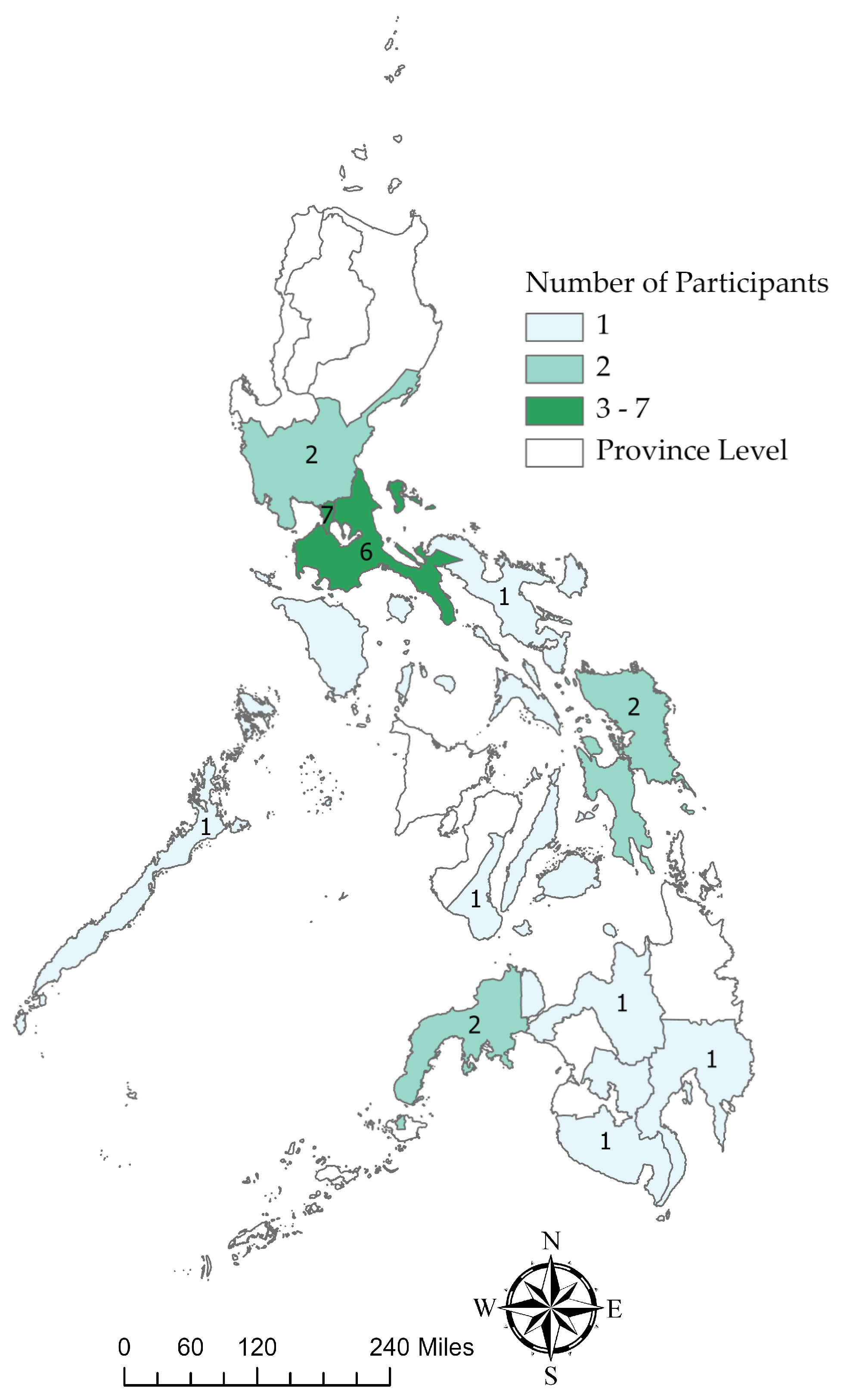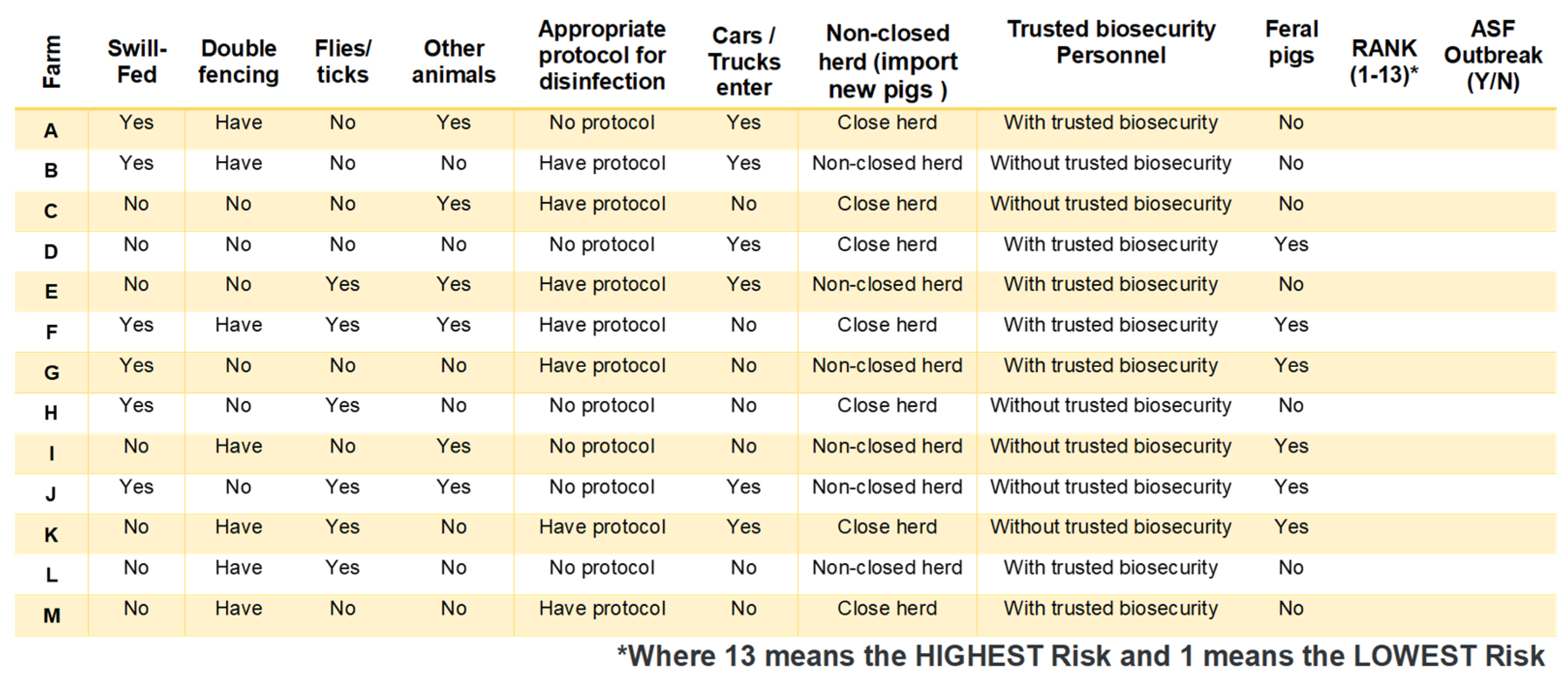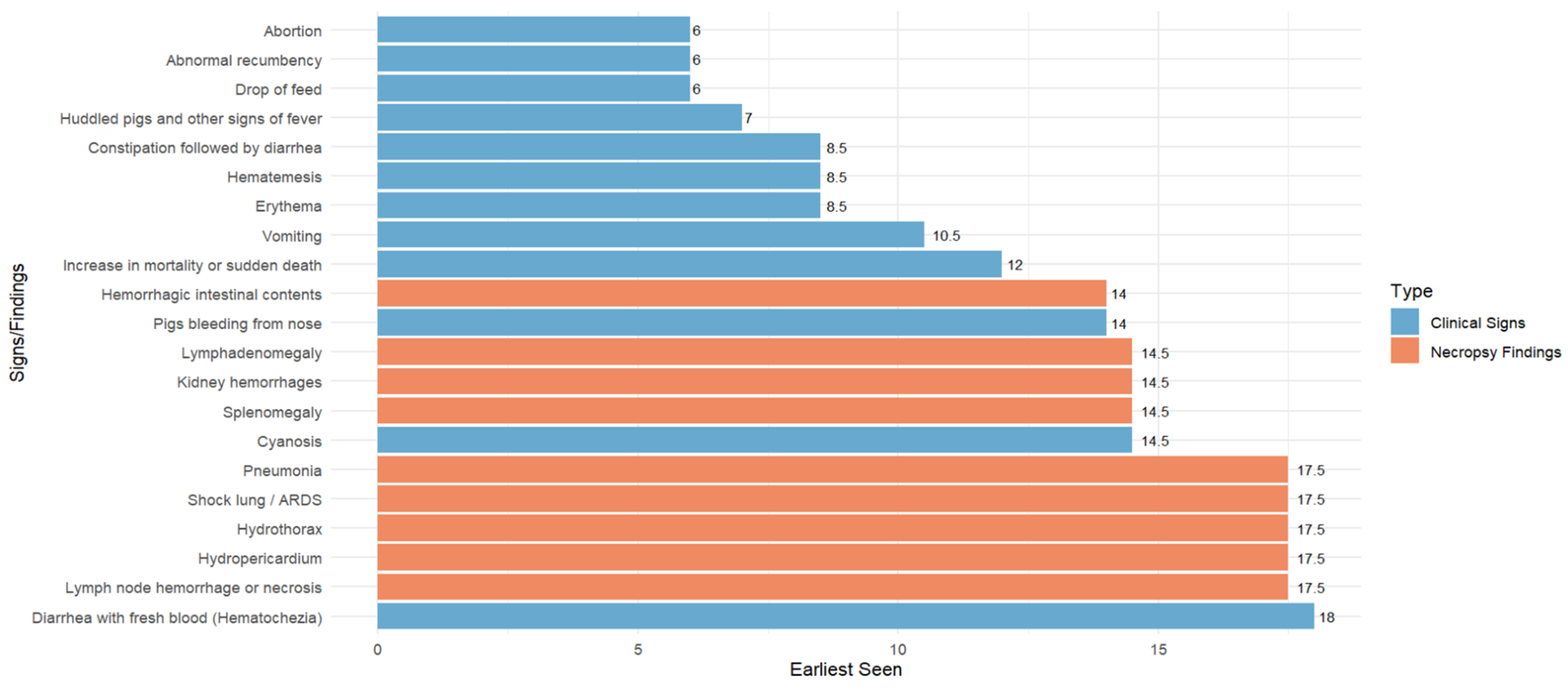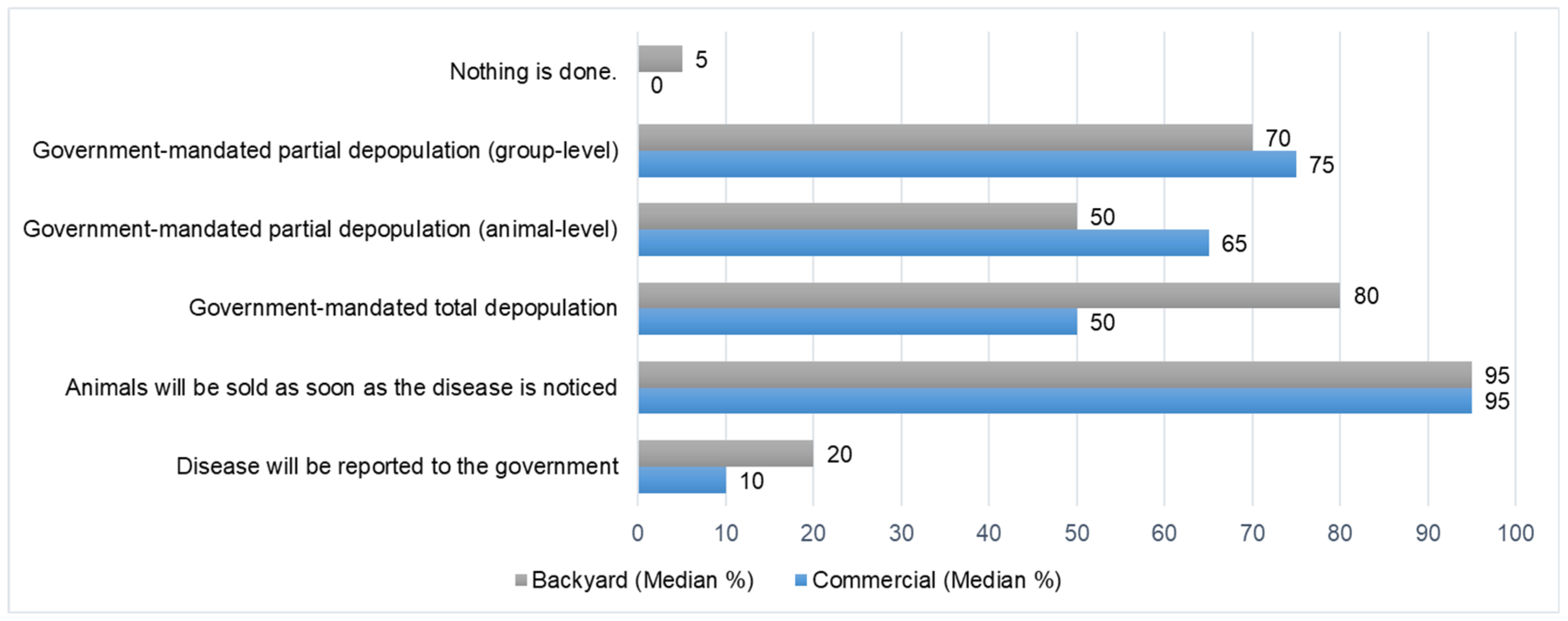Factors Affecting the Spread, Diagnosis, and Control of African Swine Fever in the Philippines
Abstract
:1. Introduction
2. Materials and Methods
2.1. General Approach
2.2. Expert Selection
2.3. Conjoint Analysis
2.4. Quantitative ASF Information Collection through World Café Discussion
2.5. SWOT Analysis
2.6. Statistical Analyses
2.6.1. Logistic and Ordinal Regression Models
2.6.2. Statistical Analyses World Café Discussion and SWOT Analysis
3. Results
3.1. Conjoint Analysis
3.2. World Café Discussion
3.3. SWOT Analysis
4. Discussion
Supplementary Materials
Author Contributions
Funding
Institutional Review Board Statement
Informed Consent Statement
Data Availability Statement
Acknowledgments
Conflicts of Interest
References
- Blome, S.; Franzke, K.; Beer, M. African Swine Fever—A Review of Current Knowledge. Virus Res. 2020, 287, 198099. [Google Scholar] [CrossRef] [PubMed]
- Dixon, L.K.; Sun, H.; Roberts, H. African Swine Fever. Antivir. Res. 2019, 165, 34–41. [Google Scholar] [CrossRef] [PubMed]
- Ge, S.; Li, J.; Fan, X.; Liu, F.; Li, L.; Wang, Q.; Ren, W.; Bao, J.; Liu, C.; Wang, H.; et al. Molecular Characterization of African Swine Fever Virus, China, 2018. Emerg. Infect. Dis. 2018, 24, 2131–2133. [Google Scholar] [CrossRef] [PubMed]
- OIE. African Swine Fever, Philippines (Immediate Notification); OIE: Manila, Philippines, 2019. [Google Scholar]
- Hsu, C.-H.; Montenegro, M.; Perez, A. Space–Time Dynamics of African Swine Fever Spread in the Philippines. Microorganisms 2023, 11, 1492. [Google Scholar] [CrossRef] [PubMed]
- Tambago, E.R. Philippine Hog Industry Roadmap Development Team. Available online: https://psa.gov.ph/content/swine-situation-report-january-march-2023 (accessed on 20 June 2023).
- Swine Situation Report, January to March 2023. Available online: www.pcaf.da.gov.ph/wp-content/uploads/2022/06/Philippine-Hog-Industry-Roadmap-2022-2026.pdf (accessed on 20 June 2023).
- Gaudreault, N.N.; Madden, D.W.; Wilson, W.C.; Trujillo, J.D.; Richt, J.A. African Swine Fever Virus: An Emerging DNA Arbovirus. Front. Vet. Sci. 2020, 7, 215. [Google Scholar] [CrossRef] [PubMed]
- Rao, V.R. Applied Conjoint Analysis; Springer: Berlin/Heidelberg, Germany, 2014; ISBN 978-3-540-87752-3. [Google Scholar]
- Applied Conjoint Analysis|SpringerLink. Available online: https://link-springer-com.ezp2.lib.umn.edu/book/10.1007/978-3-540-87753-0 (accessed on 20 June 2023).
- Van Den Borne, B.H.P.; Van Soest, F.J.S.; Reist, M.; Hogeveen, H. Quantifying Preferences of Farmers and Veterinarians for National Animal Health Programs: The Example of Bovine Mastitis and Antimicrobial Usage in Switzerland. Front. Vet. Sci. 2017, 4, 82. [Google Scholar] [CrossRef] [PubMed]
- Schettino, D.N.; Abdrakhmanov, S.K.; Beisembayev, K.K.; Korennoy, F.I.; Sultanov, A.A.; Mukhanbetkaliyev, Y.Y.; Kadyrov, A.S.; Perez, A.M. Risk for African Swine Fever Introduction into Kazakhstan. Front. Vet. Sci. 2021, 8, 605910. [Google Scholar] [CrossRef] [PubMed]
- Teoli, D.; Sanvictores, T.; An, J. SWOT Analysis. In StatPearls; StatPearls Publishing: Treasure Island, FL, USA, 2022. [Google Scholar]
- Do a SWOT Analysis. Available online: https://www.cdc.gov/publichealthgateway/phcommunities/resourcekit/evaluate/do-a-swot-analysis.html (accessed on 28 February 2022).
- Schambow, R.; Reyes, R.; Morales, J.; Diaz, A.; Perez, A.M. A Qualitative Assessment of Alternative Eradication Strategies for African Swine Fever in the Dominican Republic. Front. Vet. Sci. 2022, 9, 1054271. [Google Scholar] [CrossRef] [PubMed]
- Schettino, D.M.; Perez, A.; Lantigua, E.; Beemer, O.; Remmenga, M.; Vanicek, C.; Lopes, G.; Arzt, J.; Reyes, R. Enhanced Passive Surveillance for Early Detection of African and Classical Swine Fevers: -EN- Enhanced Passive Surveillance for Early Detection of African and Classical Swine Fevers -FR- Surveillance Passive Renforcée Pour La Détection Précoce Des Pestes Porcines Africaine et Classique -ES- Vigilancia Pasiva Reforzada Para La Pronta Detección de Las Pestes Porcinas Africana y Clásica. Rev. Sci. Tech. OIE 2023, 42, 149–160. [Google Scholar] [CrossRef]
- Organisation des Nations Unies pour L’alimentation et L’agriculture (Ed.) Good Practices for Biosecurity in the Pig Sector: Issues and Options in Developing and Transition Countries; FAO Animal Production and Health Paper; FAO: Rome, Italy, 2010; ISBN 978-92-5-106507-5. [Google Scholar]
- Bremang, A.; Ho, H.P.J.; Conan, A.; Tang, H.; Oh, Y.; Pfeiffer, D.U. Guidelines for African Swine Fever (ASF) Prevention and Control in Smallholder Pig Farming in Asia; Food and Agriculture Organization of the United Nations: Québec City, QC, Canada, 2022. [Google Scholar]
- Venables, W.N.; Ripley, B.D. Modern Applied Statistics with S, 4th ed.; Springer: New York, NY, USA, 2002; ISBN 0-387-95457-0. [Google Scholar]
- Lele, S.R.; Keim, J.L.; Solymos, P. ResourceSelection (Probability) Functions for Use-Availability 2019. Available online: https://cran.r-project.org/web/packages/ResourceSelection/index.html (accessed on 20 June 2023).
- Cheng, J.; Ward, M.P. Risk Factors for the Spread of African Swine Fever in China: A Systematic Review of Chinese-language Literature. Transbound. Emerg. Dis. 2022, 69, e1289. [Google Scholar] [CrossRef] [PubMed]
- Kedkovid, R.; Sirisereewan, C.; Thanawongnuwech, R. Major Swine Viral Diseases: An Asian Perspective after the African Swine Fever Introduction. Porc. Health Manag. 2020, 6, 20. [Google Scholar] [CrossRef] [PubMed]
- Cadenas-Fernández, E.; Ito, S.; Aguilar-Vega, C.; Sánchez-Vizcaíno, J.M.; Bosch, J. The Role of the Wild Boar Spreading African Swine Fever Virus in Asia: Another Underestimated Problem. Front. Vet. Sci. 2022, 9, 844209. [Google Scholar] [CrossRef] [PubMed]
- Distribution of Sus Philippensis. Red—Extant (Resident). Data Sourced from IUCN Red List, World Bank Country Polygons (Licensed under Creative Commons Attribution 4.0); Amante, C.; Eakins, B.W. ETOPO1 1 Arc-Minute Global Relief Model: Procedures, Data Sources and Analysis. NOAA Technical Memorandum NESDIS NGDC-24, 19p. 2009. Available online: https://commons.wikimedia.org/wiki/File:Range_Sus_philippensis.png (accessed on 20 June 2023).
- Fishbein, D.B.; Miranda, N.J.; Merrill, P.; Camba, R.A.; Meltzer, M.; Carlos, E.T.; Bautista, C.F.; Sopungco, P.V.; Mangahas, L.C.; Hernandez, L.M.; et al. Rabies Control in the Republic of the Philippines: Benefits and Costs of Elimination. Vaccine 1991, 9, 581–587. [Google Scholar] [CrossRef] [PubMed]
- Dizon, T.J.R.; Saito, N.; Inobaya, M.; Tan, A.; Reñosa, M.D.C.; Bravo, T.A.; Endoma, V.; Silvestre, C.; Salunga, M.A.O.; Lacanilao, P.M.T.; et al. Household Survey on Owned Dog Population and Rabies Knowledge in Selected Municipalities in Bulacan, Philippines: A Cross-Sectional Study. PLoS Negl. Trop. Dis. 2022, 16, e0009948. [Google Scholar] [CrossRef] [PubMed]
- Carlson, J.; Fischer, M.; Zani, L.; Eschbaumer, M.; Fuchs, W.; Mettenleiter, T.; Beer, M.; Blome, S. Stability of African Swine Fever Virus in Soil and Options to Mitigate the Potential Transmission Risk. Pathogens 2020, 9, 977. [Google Scholar] [CrossRef] [PubMed]
- Sánchez-Vizcaíno, J.M.; Mur, L.; Gomez-Villamandos, J.C.; Carrasco, L. An Update on the Epidemiology and Pathology of African Swine Fever. J. Comp. Pathol. 2015, 152, 9–21. [Google Scholar] [CrossRef] [PubMed]




| No. | Risk Factors | High-/Low-Risk Response |
|---|---|---|
| 1 | Swill-fed or potential contamination of feed ingredients | Yes/No |
| 2 | Lack of double fencing | No double fencing/Have double fencing |
| 3 | Presence of flies and ticks | Yes/No |
| 4 | Presence of small and domestic mammals (e.g., rats, dogs, cats, or other farm animals) | Yes/No |
| 5 | Absence of protocols for changing clothes, separate entries and exits, disinfection of objects restrictions on food introduction, and external individuals accessing the farm | No appropriate protocols/Have appropriate protocols |
| 6 | Allowance for cars and trucks to enter premises | Cars and trucks can enter premises/Cars and trucks cannot enter premises |
| 7 | Non-closed herd with recent introduction of new animals (requiring importation of pigs) without a quarantine station within 1 km from premises or sharing of personnel | Non-closed herd/Closed herd |
| 8 | Movement of personnel (including vets, inseminators, and technicians) between this farm and other farms without trusted biosecurity measures | Personnel without trusted biosecurity measures/Personnel with trusted biosecurity measures |
| 9 | Area with presence of feral pigs | Yes/No |
| Logistic Regression Model | Ordinal Logistic Regression | |||||||||||
|---|---|---|---|---|---|---|---|---|---|---|---|---|
| Description | Coefficient | CI (95%) | Odds Ratio | SE | p-Value | Sig. | Coefficient | SE | Common Odds Ratio | CI (95%) | p-Value | Sig. |
| Swill-fed/Contaminated feed | 1.8740 | (1.28, 2.54) | 6.5143 | 0.3167 | <0.001 | *** | 2.988 | 0.258 | 19.8459 | (12.09, 33.22) | 3.92 × 10−31 | *** |
| Absence of double fencing | 0.4526 | (−0.13, 1.09) | 1.5723 | 0.3067 | 0.14001 | 1.611 | 0.235 | 5.0078 | (3.18, 7.99) | 6.57 × 10−12 | *** | |
| Presence of flies and ticks | 0.7355 | (0.15, 1.38) | 2.0865 | 0.3080 | 0.01696 | * | 1.936 | 0.237 | 6.93 | (4.38, 11.12) | 3.56 × 10−16 | *** |
| Presence of other animals | 0.8089 | (0.26, 1.38) | 2.2454 | 0.2866 | 0.00476 | ** | 1.558 | 0.231 | 4.749 | (3.04, 7.53) | 1.57 × 10−11 | *** |
| Absence of a protocol for disinfection | 0.9682 | (0.38, 1.61) | 2.6332 | 0.3092 | 0.00174 | ** | 2.02 | 0.242 | 7.538 | (4.73, 12.21) | 6.61 × 10−17 | *** |
| Cars/trucks enter | 0.4669 | (−0.07, 1.02) | 1.595 | 0.2779 | 0.09293 | 1.401 | 0.232 | 4.059 | (2.59, 6.44) | 1.45 × 10−9 | *** | |
| Non-close herd | 0.3551 | (−0.20, 0.92) | 1.4263 | 0.2829 | 0.20937 | 1.693 | 0.231 | 5.4357 | (3.48, 8.61) | 2.45 × 10−13 | *** | |
| Personnel without trusted biosecurity | 0.9593 | (0.37, 1.60) | 2.6099 | 0.3094 | 0.00193 | ** | 2.408 | 0.249 | 11.11 | (6.88, 18.26) | 3.51 × 10−22 | *** |
| Area with feral pigs | 0.4925 | (−0.06, 1.05) | 1.6364 | 0.2825 | 0.08126 | 1.463 | 0.233 | 4.3189 | (2.75, 6.87) | 3.40 × 10−10 | *** | |
| Infection Route | Commercial (Normalized Median, %) | Backyard (Normalized Median, %) |
|---|---|---|
| Introduction of sick pigs | 9.9 | 15.8 |
| Environmental contamination (water courses, rice fields next to the farm, contact with backyard farms, etc.) | 17.7 | 13 |
| Contaminated vehicles entering the farm | 29.6 | 16.4 |
| Contaminated people entering the farm | 20.2 | 22.6 |
| Feed | 7.9 | 13.6 |
| Wild boars | 0 | 5.1 |
| Rodents, flies, and other potential vectors | 14.8 | 13.6 |
| Other | 0 | 0 |
| Total | 100 | 100 |
| Clinical Sign | Median Frequency (%) | Median Likelihood of Producer Seeing (%) |
|---|---|---|
| Drop in feed consumption | 99.5 | 100 |
| Huddled pigs and other signs of fever | 85 | 100 |
| Reluctances to stand up and move (abnormal recumbence) | 85 | 100 |
| Reddish in the skin (Erythema) | 65 | 100 |
| Abortion | 65 | 100 |
| Increase in mortality or sudden death | 64.5 | 100 |
| Diarrhea with fresh blood (hematochezia) | 35 | 100 |
| Cyanosis (blue areas) of ears and limbs | 30 | 100 |
| Pigs bleeding from nose | 28 | 100 |
| Vomiting with blood (hematemesis) | 12.5 | 75 |
| Constipation followed by diarrhea | 10 | 25 |
| Vomiting | 5 | 100 |
| Necropsy Findings | Median Frequency (%) | Median Likelihood of Producer Seeing (%) |
| Splenomegaly | 100 | 25 |
| Kidney hemorrhages | 80 | 25 |
| Lymphadenomegaly | 65 | 25 |
| Lymph node hemorrhage or necrosis | 50 | 25 |
| Hemorrhagic intestinal contents | 50 | 66.7 |
| Hydropericardium | 11 | 25 |
| Hydrothorax | 11 | 25 |
| Shock lung/acute respiratory distress syndrome | 10 | 25 |
| Pneumonia | 10 | 25 |
| Strengths | Weaknesses |
|---|---|
| 1. National Control Policy and ASF task force. 2. Collaboration between different levels of government (central level and local governmental units). 3. Evidence-based approach. 4. Philippines Statistics Authority has a regular report of inventory of swine and farmers, including type of production. | 1. Farmers face difficulties due to the absence of adequate compensation and a lack of trust in the government’s support. This leads to resistance to reporting ASF cases due to the absence of incentives and negative public opinion. 2. The value chain lacks an established traceability system, making it difficult to track and map the routes of hog traders (viajeros), which hinders effective control measures. 3. Lack of resources. There are significant resource constraints in terms of manpower and testing capacity. Limited manpower affects the implementation of control measures, and although the testing capacity has improved, the efficiency of diagnostic PCR testing (RADDL) results in delayed reporting, which hampers timely control efforts. |
| Opportunities | Threats |
| 1. Social media such as Facebook fan page or TikTok for dissemination of ASF prevention information. 2. Rapid adoption of responsible technology in diagnostics. 3. Environmental compliance and regulatory practices for related industries. 4. Recent vaccine trials. 5. Improvement in the execution of biosecurity measures and culture. | 1. Risk factors such as human/trade movement and vectors in the Philippines. 2. Dwindling number of new swine veterinarians. 3. Issues with slaughterhouse compliance, tampering with documents, and border control corruption. 4. Time to detection of ASF. |
Disclaimer/Publisher’s Note: The statements, opinions and data contained in all publications are solely those of the individual author(s) and contributor(s) and not of MDPI and/or the editor(s). MDPI and/or the editor(s) disclaim responsibility for any injury to people or property resulting from any ideas, methods, instructions or products referred to in the content. |
© 2023 by the authors. Licensee MDPI, Basel, Switzerland. This article is an open access article distributed under the terms and conditions of the Creative Commons Attribution (CC BY) license (https://creativecommons.org/licenses/by/4.0/).
Share and Cite
Hsu, C.-H.; Schambow, R.; Montenegro, M.; Miclat-Sonaco, R.; Perez, A. Factors Affecting the Spread, Diagnosis, and Control of African Swine Fever in the Philippines. Pathogens 2023, 12, 1068. https://doi.org/10.3390/pathogens12081068
Hsu C-H, Schambow R, Montenegro M, Miclat-Sonaco R, Perez A. Factors Affecting the Spread, Diagnosis, and Control of African Swine Fever in the Philippines. Pathogens. 2023; 12(8):1068. https://doi.org/10.3390/pathogens12081068
Chicago/Turabian StyleHsu, Chia-Hui, Rachel Schambow, Maximino Montenegro, Ruth Miclat-Sonaco, and Andres Perez. 2023. "Factors Affecting the Spread, Diagnosis, and Control of African Swine Fever in the Philippines" Pathogens 12, no. 8: 1068. https://doi.org/10.3390/pathogens12081068
APA StyleHsu, C.-H., Schambow, R., Montenegro, M., Miclat-Sonaco, R., & Perez, A. (2023). Factors Affecting the Spread, Diagnosis, and Control of African Swine Fever in the Philippines. Pathogens, 12(8), 1068. https://doi.org/10.3390/pathogens12081068








